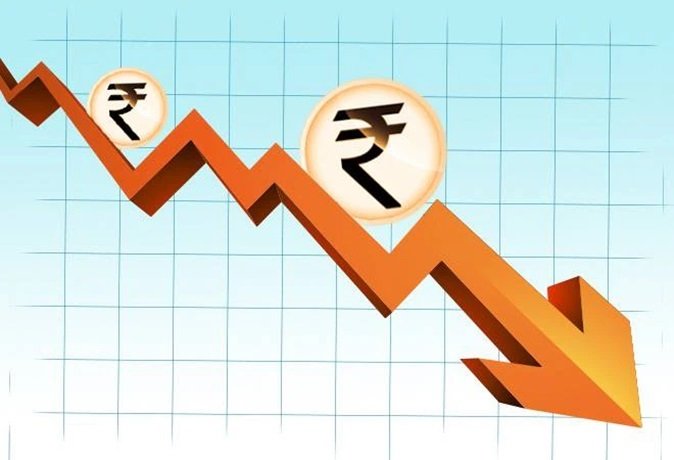
Why Indian Rupee is Falling? Could $ 1 = ₹ 100 Soon?
The decline of the Indian rupee is volatile, with its exchange rate poised to breach ₹90 after crossing the ₹80 mark against the US dollar—a threshold never before reached. This downward twist has garnered relentless media attention, with many attributing this decline to a complex interplay of historical, economic, and geopolitical factors, including shifts observed since Donald Trump’s tenure.
Historical Decline: The Rupee and the Dollar’s Shadow
The Indian rupee’s dependency on foreign currencies traces back millennia. Roman historian Pliny lamented how India’s allure for its textiles and gemstones spent Rome’s funds, initiating a legacy of economic imbalance. French traveler Franco Baner later documented the eastward movement of gold and silver, signifying India’s magnetic pull for precious metals—yet the wealth eventually rested inactively rather than flourishing.
India once announced as the “Golden Bird,” is now affixed in economic constraints. This rapid shift over just seven decades remains mysterious, considering its historic prosperity. The ascent of the dollar as the unmatched global currency further makes things worse this dynamic, overshadowing even the British Pound’s former dominance.
Economic Ability of Ancient India
India’s remarkable economic heritage is rooted in the Indus Valley Civilization of 3100 BC, increased under the rule of Chandragupta Maurya. The foundation for a strong financial system that flourished for centuries was laid by a united governing structure that introduced silver coins with bloom plans.
With trade tariffs on goods like textiles and pearls providing a substantial source of income, the Mauryan Empire turned India into an export powerhouse. By the sixth century AD, Europe’s persistent need for Indian products—from beautiful linens to spices like black pepper, known as “black gold”—had increased the subcontinent’s GDP to 25% of the global total.
How Foreign Exchange Shapes Currencies
A currency’s value, dictated by the principles of foreign exchange (Forex), reflects its demand on the global stage. The US dollar reigns supreme, serving as the benchmark for international trade. In contrast, nations like China, with its surplus-driven trade strategy, increase the value of the Yuan by exporting regularly. However, because its imports outweigh its exports, India struggles with a trade deficit of more than $20 billion.
The difference results from previous use of resources in India during the British and Mughal periods. In order to promote economic dependency, natural assets were taken out, refined elsewhere, and then sold back to India.

The Impact of the British Legacy
A significant change was brought about by the British Empire’s adoption of the Gold Standard in 1821. Paper money backed by precious metals was introduced when the value of the pound was fixed at par with gold. Subsequent regulations, such as the Currency Act of 1835, standardized the Indian rupee and associated it with silver. The rupee’s value declined as a result of this depreciation plan, which reduced India’s imports of gold and silver.
These difficulties were made worse by world wars. Britain pumped markets with low-value currency in response to the financial demands of war, which affected the rupee’s reputation internationally. The US dollar became a global force after the war, strengthening its status with the 1944 Bretton Woods Agreement.
Current Difficulties and the Future Path
Following its independence, India’s economy has seen numerous shocks, including the COVID-19 pandemic, international oil problems, and conflicts with China and Pakistan. The rupee is currently trading at about 84 to the dollar, and forecasts indicate that it will continue to decline due to global tensions, such as the conflict between Russia and Ukraine.
Why Indian Rupee is Falling?
USA President Trump-era policies—such as heightened tariffs, tax reforms, and changes to visa regulations—have further strained Indo-US trade dynamics. For instance, restricting H1-B visas curtails Indian remittances, weakening the rupee’s support structure.
Given that 80% of India’s energy demands are met by oil imports, the country must switch to renewable energy sources and increase exports. Long-term rupee stability may be achieved by increasing remittances and strengthening trade connections.
Conclusion:
Why Indian Rupee is Falling? A Way Forward
The volatile fall of the Indian rupee shows the difficulties of a globalized economy. Despite the fact that past misdeeds and outside influences have influenced its development, India’s resolve gives hope. The goal of programs like “Make in India” is to reduce dependency on imports and increase local production.
The path of the rupee can be better understood by understanding this complicated structure of economics, past history, and policy. India can negotiate these difficult conditions and even strengthen its currency on the international scene by addressing systemic problems and encouraging innovation.
Finally, the strength of the currency is also influenced by the structure of foreign investment. The Rupee may depreciate as a result of decreased demand brought on by a decline in foreign direct investment or portfolio inflows. Any indication of economic instability may cause investors to pull out of the market as they look for stability, which would further depreciate the currency.




































